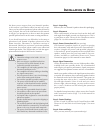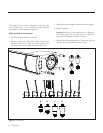
10 Controls and Connection
By now your speakers should be placed approximately
two to three feet from the front wall (the wall in front of
the listening position) and at least two feet from the side
walls. Your sitting distance should be further than the dis-
tance between the speakers themselves. You are trying to
attain the impression of good center imaging and stage
width.
The correct distance between the speakers and listener is
related to the size and shape of your room. In long rooms
the distance between the speakers may be far less than
the distance from you to the speaker system. However,
in a wide room, you will still find that if the distance from
the listener to the speakers becomes smaller than the dis-
tance between the speakers themselves, the image will no
longer focus in the center.
Now that you have positioned your speaker system,
spend time listening. Wait to make any major changes
for
the next few days.
Over the first 72 hours of play the actu-
al tonal quality will change slightly with deeper bass and
more spacious highs resulting. After a few days of listening
you can make refinements and hear the differences.
The Wall Behind the Listener
Near-field reflections can occur from your back wall (the
wall behind the listening position). If your listening posi-
tion is close to the back wall, these reflections can confuse
imaging quality. It is better for the wall behind you to be
absorptive than to be reflective. If you have a hard back
wall and your listening position is close to it, experiment
with devices that absorb sound (i.e. wall hangings and
possibly even sound absorbing panels).
The Wall Behind the Speakers
The front surface, the wall behind the speakers, should
not be extremely hard or soft. A pane of glass will cause
reflections, brightness and confused imaging. Curtains,
drapery and objects such as bookshelves can be placed
along the wall to diffuse an overly reflective surface. A
standard sheet rock or textured wall is generally an ade-
quate surface if the rest of the room is not too bright and
hard. Walls can also be too soft. If the entire front wall
consists of heavy drapery, your system can sound dull.
You may hear muted music with little ambience. Harder
surfaces will actually help in this case.
The front surface should be one long wall without any
doors or openings. If you have openings, the reflection and
bass characteristics from each channel can be different.
The Side Walls
A good rule of thumb is to have the side walls as far away
from the speakers as possible. However, MartinLogan’s
unique controlled dispersion electrostatic transducer
inherently minimizes side wall reflections—a position
as little as two feet from the side walls often proves ade-
quate. Sometimes, if the system is bright or the imaging
is not to your liking, and the side walls are very near, try
putting curtains or softening material to the side of each
speaker.
PlaCement and room aCoustICs
Listening Position
Figure 2. Loudspeaker placement
2x
x
>24”
(>61cm)
>24”
(>61cm)
x


















